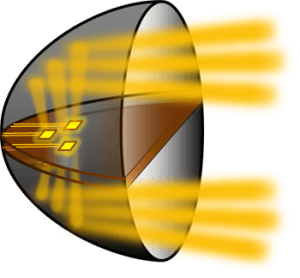 By Lee PickeringFeb 16 2018
By Lee PickeringFeb 16 2018An innovative LED-based train headlight that consumes just 1/10th of the energy needed for headlights running on traditional light sources has been developed by scientists. Upon being lit every day for 8 hours, the electricity savings of the innovative headlight would decrease the emission of carbon dioxide, a greenhouse gas, by nearly 152 kg in a year.
 A new train headlight design uses two half-circular parabolic, or cup-shaped, aluminized reflectors with high-efficiency LEDs placed in the plane where the two reflectors come together. Combining the strong beams from each reflector generates the light intensity necessary to meet safety guidelines. (Image credit: Wei-Lun Liang, National Taiwan University)
A new train headlight design uses two half-circular parabolic, or cup-shaped, aluminized reflectors with high-efficiency LEDs placed in the plane where the two reflectors come together. Combining the strong beams from each reflector generates the light intensity necessary to meet safety guidelines. (Image credit: Wei-Lun Liang, National Taiwan University)
Apart from illuminating the tracks ahead, train headlights also have a vital role in rail transportation. As trains cannot be stopped easily, their headlights ought to be visible from a very farther distance to offer enough time to vehicles or people on tracks to clear the tracks. Conventional train headlights, including halogen or incandescent bulbs, are adequately bright to satisfy the safety regulations. However, they are not very energy-effective as a major portion of the energy powering the light is transformed into heat and not visible light.
A team headed by Guo-Dung J. Su from the Micro-Optics Device Laboratory at the Graduate Institute of Photonics and Optoelectronics at National Taiwan University, Taiwan, was consulted by Lab H2 Inc., an engineering and design company, to develop locomotive headlights with LEDs as the light source. Apart from decreasing the amount of energy required, the life of LEDs is longer, and they are also compact and highly robust when compared to conventional light sources.
Some LED headlight products sold on the market are designed with many LEDs that have outputs that overlap in large sections. These designs waste a lot of energy. Our research showed that electricity use can be reduced by focusing on the best way to distribute the LED energy equally.
Wei-Lun Liang, Micro-Optics Device Laboratory
In Applied Optics, a journal published by The Optical Society, Liang and Su have described the innovative train headlight design, which is dependent on 10 accurately positioned, highly efficient LEDs. The headlight requires, in total, 20.18 Watts to achieve a light intensity similar to that of a halogen or incandescent lamp that requires several hundred watts. The brightness of the innovative headlight can also be decreased by switching off certain LEDs to prevent waiting passengers from being blinded when the train passes a platform, for instance.
Designing for Energy Efficiency
Similar to the headlights used in cars, in train headlights a light source is usually integrated with a cup-shaped, or parabolic, reflective surface focusing the emitted light into a beam. Despite the fact that LEDs are the go-to choice for saving energy, the highly energy-efficient ones emit smaller light spots. Hence, the scientists had to integrate the minimal outputs of several high-efficiency LEDs into a larger circular output to develop a beam adequately large to be used as a train headlight.
“Combining several LEDs is more expensive and consumes more electricity than using a few single LEDs,” stated Liang. “Thus, we needed to determine how to best position the lowest possible number of high-efficiency LEDs needed to meet the requirements by analyzing how the parabolic surface reflected the LED lights.
Wei-Lun Liang, Micro-Optics Device Laboratory
The team aimed to develop a headlight that would emit light that had brightness 1.25 times of that necessitated by U.S. federal regulations, which mandate train headlights to have a peak intensity of at least 200,000 candelas and to illuminate an individual at least 800 feet ahead of the headlight.
Locating the LEDs to conserve energy and to satisfy federal guidelines posed various difficulties. The team had to cautiously overlap the LED outputs good enough to develop a large beam, but not to the extent that higher number of LEDs, and hence higher energy, would be required. Moreover, the LEDs have to be positioned adequately spaced from one another to enable heat dissipation to avoid damage to the circuit.
Positioning the LEDs
To design a highly efficient train headlight, the team used two half-circular parabolic aluminized reflectors together. The strong beams from each of the reflectors combined to produce the light intensity needed to satisfy federal guidelines. The design also made the positioning of the circuits required to power the LEDs easier as they could be located inside the horizontal divider separating the reflectors.
In order to choose the apt spot for positioning the LEDs in the reflectors, the team initially evaluated the apt location for each LED and then performed a sequence of simulations and investigations to adjust the final position for each LED depending on its corresponding illumination pattern.
Other scientists can use the linear equation we derived for deciding the approximate positions of LEDs for other applications. This can substantially shorten the time required to determine LED positioning before fine-tuning the positions.
Wei-Lun Liang, Micro-Optics Device Laboratory
The team indicates that normally, a complete parabolic reflector surface is used in headlights. “We believe this is the first design to use a combination of two semi-parabolic reflector surfaces,” stated Liang. “By systematically analyzing the design to determine the best placement of the LEDs in the reflector, we were able to minimize electricity consumption while satisfying requirements associated with traffic safety.”
At present, the scientists are striving to commercialize their design. Although the new design seems to consume low power, it still produces a certain amount of residual heat. Prior to commercialization of the design, the team will have to design and investigate a heat dissipation system for the innovative headlight.